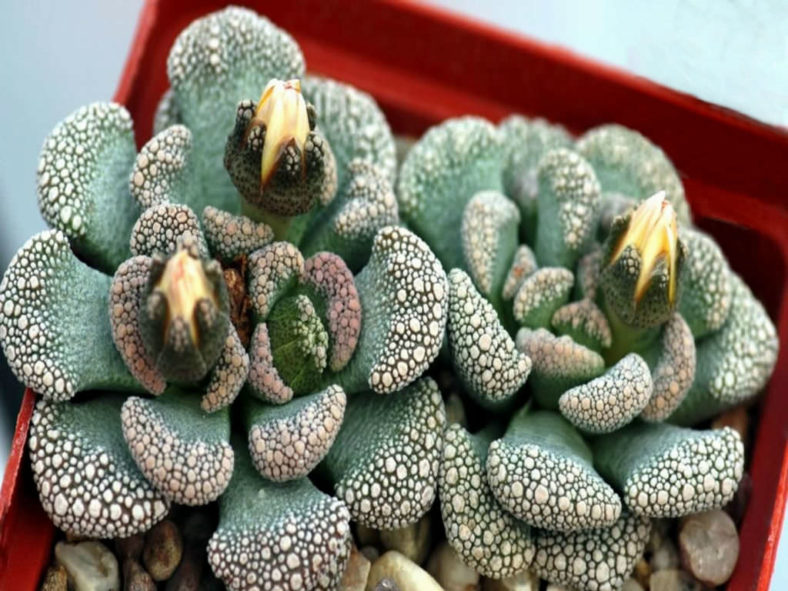Scientific Name
Titanopsis calcarea (Marloth) Schwantes
Common Name(s)
Concrete Leaf, Concrete Leaf Living Stone, Jewel Weed, Carpet Leaf, Sheep's Tongue, Living Stone
Synonym(s)
Titanopsis calcareum
Scientific Classification
Family: Aizoaceae
Subfamily: Ruschioideae
Genus: Titanopsis
Etymology
The specific epithet "calcarea" (pronounced "kal-KAR-ee-uh") means "chalky" and refers to the distinctive, chalky appearance of this species.
Origin
Titanopsis calcarea is native to South Africa (Bushmanland, Upper Karoo).
Description
Titanopsis calcarea is a mat-forming succulent that forms rosettes of usually grey or blue-green leaves densely covered at the apex with rough, whitish, creamy-grey, ocher, red, or bluish tubercles. The rosettes can grow up to 3 inches (7.5 cm) in diameter. The leaves are thick, fleshy, with a truncated tip, and can measure up to 1 inch (2.5 cm) long.
The flowers are yellow to orange and can reach a diameter of 0.8 inches (2 cm).
Forms

Hardiness
USDA hardiness zones 9a to 11b: from 20°F (-6.7°C) to 50°F (10°C).
How to Grow and Care
Like many South African desert plants, Concrete Leaf Living Stone tends to become dormant or semi-dormant during the height of summer to conserve moisture. Keeping the plants wet during mid-summer is often a mistake, although they require some water during this period.
The members of the genus Titanopsis are all similar plants that seem to make most of their growth in the fall, with another shorter burst in the spring. They may produce flowers in fall, spring, or both. This beautiful little plant is worthy of a place in most collections. Concrete Leaf Living Stone is quite tolerant of temperatures down to 40°F (5°C) if kept fairly dry. Like most plants, it will benefit from good ventilation.
Concrete Leaf Living Stone should be kept in a bright, sunny situation. It will grow well in a south-facing window.
Water this succulent well during the spring, allowing the compost to dry between waterings. During the summer, the semi-dormant Concrete Leaf Living Stone should be watered sparingly to avoid any chance of rotting.
Learn more at How to Grow and Care for Titanopsis.
Links
- Back to genus Titanopsis
- Succupedia: Browse succulents by Scientific Name, Common Name, Genus, Family, USDA Hardiness Zone, Origin, or cacti by Genus
Photo Gallery
Click on a photo to see a larger version.


